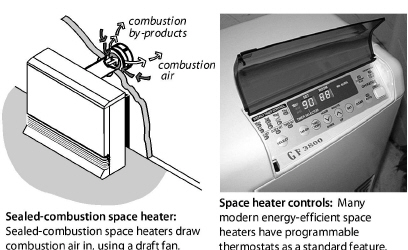
8.4 Combustion Space Heater Replacement
Space heaters are inherently more efficient than central heaters, because they have no ducts or distribution pipes.

Weatherization agencies replace space heaters as an energy-conservation measure or for health and safety reasons. Choose a sealed-combustion space heater. Inspect existing space heaters for health and safety problems.
ü If power outages are common, select a space heater that will work without electricity.
ü Follow manufacturer’s venting instructions carefully. Don’t vent sealed-combustion or induced-draft space heaters into naturally drafting chimneys.
ü Verify that flue-gas oxygen and temperature are within the ranges specified in Table 8-3 on page 238.
ü If the space heater sits on a carpeted floor, install a fire-rated floor protector.
ü Install the space heater away from traffic, draperies, and furniture.
ü Provide the space heater with a correctly grounded duplex receptacle for its electrical service.
Inform the customer of the following operating instructions.
ü Don’t store any objects near the space heater that would restrict airflow around it.
ü Don’t use the space heater to dry clothes or for any purpose other than heating the home.
ü Don’t allow anyone to lean or sit on the space heater.
ü Don’t spray aerosols near the space heater. Many aerosols are flammable or can cause corrosion to the space heater’s heat exchanger.
|
SWS Detail: 2.0202.1 Unvented Space Heaters: Propane, Natural Gas, and Kerosene Heaters, 2.0401.1 Air Sealing Moisture Precautions |
Unvented space heaters include ventless gas fireplaces and gas logs installed in fireplaces previously designed for wood-burning or coal-burning. These unvented space heaters create indoor air pollution because they deliver all their combustion byproducts to the indoors. Unvented space heaters aren’t safe. Replace them with vented space heaters or electric space heaters.
DOE forbids unvented space heaters as primary heating units in weatherized homes. However, unvented space heaters may be used as secondary heaters, under these four requirements.
1. The heater must have a input rating less than 40,000 BTUH.
2. If located in a bedroom, the heater must have an input rating of less than 10,000 BTUH.
3. The heater must be equipped with an oxygen-depletion sensor.
4. The room containing the heater must have adequate combustion air.
5. Home must have adequate ventilation: See “Whole-Building Ventilation” on page 346.